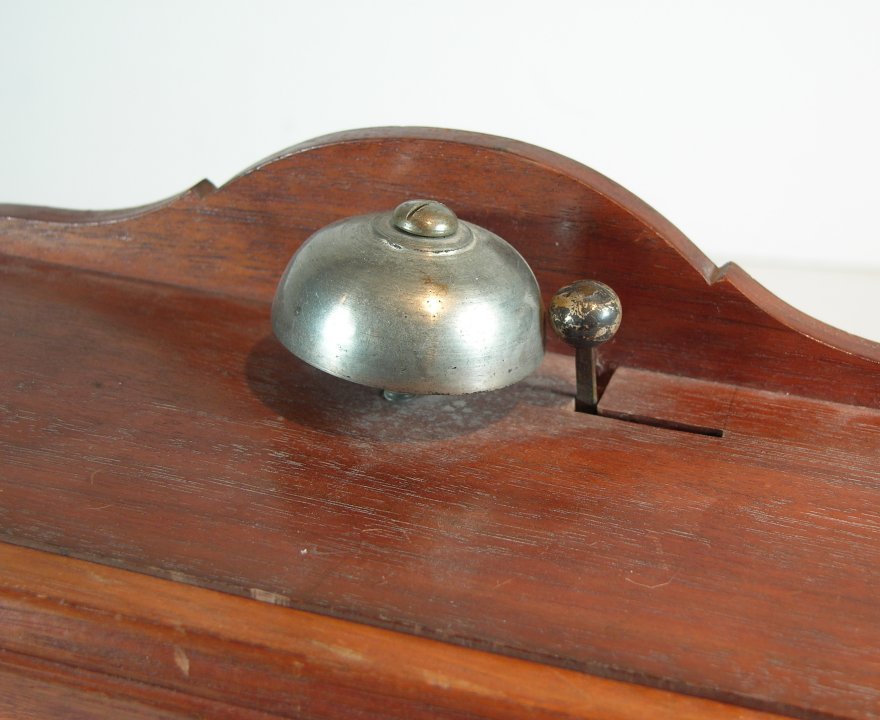CVTreasures
Patent Office Patent Model Railroad Train Station Indicator 1876
Patent Office Patent Model Railroad Train Station Indicator 1876
Make an Offer
Couldn't load pickup availability
Antique Vintage Salesman samples antiques and miniatures
1876 US Patent Office Patent Model Sample
Railroad Train / Trolley Station Indicator
Worthy of a Museum, why not in your home!
Here’s a Rare Historical Artifact you’ve never seen before and will never see again. For mid 19th Century Railroad and Travel Industry
Extremely rare and wonderful, original 1876 United States Patent Office Model being a Railroad Station Indicator Device used on Trains, Horse Drawn Street Cars and Steamships to let passengers know which station or stop the Train was approaching. This fantastic and expertly crafted device is a mahogany and walnut Indicator Box measuring approx. 8 1/4" tall at the back splash and 10” by 5" at the base. It is an exact representation of an "Improvement in Station Indicators" that was patented in 1876 under that title.
* See enlargeable images
NOTE: Over the past decade these Antique Patent Models have become a Collector Favorite and continue to skyrocket in demand and value !
Offered here is the original Patent Model of this outstanding Device used for decades on Trains and street cars to “announce” the next stop on the route. The front panel of the Station Indicator has an oval window where the name of the next station would be displayed. There is a precision brass mechanism that causes a paper or linen roll inside the Box to advance – on that sheet are the names of each of the stations along the route.
By pulling on a cord attached to the brass mechanism the roll of paper advances one “stop” and at the same time rings a rather loud bell mounted on top of the Station Indicator – the “conductor” would pull the cord – the name of the next stop would be displayed and the bell would ring to get the attention of the passengers!! Next Stop “City Park” - DING!!!
See the images above and below and the Patent drawings for a glimpse at the structure and function of this fantastic Railroad and Street Railway Station Indicator!!
The outstanding Patent Model of this finely crafted Railroad / Trolley / Steamship Station Indicator that is offered here, was actually the original Patent Model - submitted to the US Patent Office by the inventor J. Robinson Balsley of Connellsville, Pennsylvania. It came to us with the original Patent Office Tag, original Submission Tag and a modern copy of the original Patent Document dated April 29th, 1876 (just 5 days before the Battle of the Little Bighorn). The invention was issued Patent Number 178895. This wonderful, hand made Patent Model was submitted to the U. S. Patent Office as part of the patent process prescribed by law.
This simply fantastic and finely crafted example of this Train Station Indicator is 100% original and has not been restored, repaired or altered in any way. Overall the Indicator is in excellent condition - sound, intact, complete and very well preserved. It appears as it is pictured in the Patent Drawings and we have not even cleaned the dust of the device but offer it here untouched. The wood elements retain their original surfaces as well as the original stenciled lettering on one of the side panels. The enclosed paper roll is original and blank with no station lettering. The precision brass mechanism is intact and in working but may be in need of a slight adjustment Overall this outstanding and finely crafted Patent Model is exceptionally well preserved and displays beautifully.
This wonderful, 1876 Patent Model is 100% guaranteed to be the original Model that was submitted to the United States Patent Office as part of the Patent Application process. We have included a modern copy of the original Patent Papers as further documentation of this simply wonderful Patent Model.
A very rare and wonderful, 1876 United States Patent Office Model of a Railroad Station Indicator Device used on Trains, Horse Drawn Street Cars and Steamships to let passengers know which station or stop the Train or Trolley was approaching.
Share










- Choosing a selection results in a full page refresh.
- Opens in a new window.
Submit your offer. The seller will review your offer and respond to accept, decline or counter offer.











